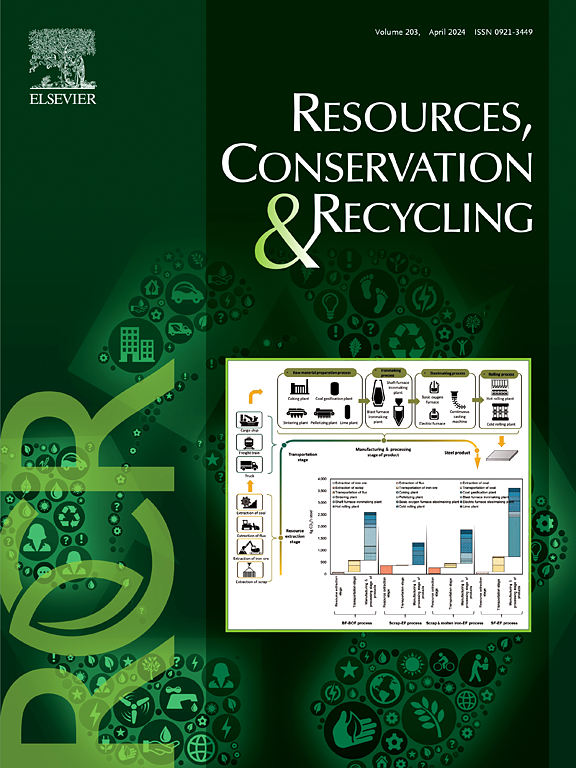在单一和联合生产中优化关键矿物的提取和加工
IF 10.9
1区 环境科学与生态学
Q1 ENGINEERING, ENVIRONMENTAL
引用次数: 0
摘要
在能源转型的背景下,高效的矿石开采和加工对于支持清洁能源技术至关重要。本研究调查了影响单一金属生产商(如铜)与联合金属生产商(如铜和钴同时生产)成本结构的经济和运营因素。值得注意的是,它解决了以下关键问题:哪些参数影响这些生产系统的成本?联合生产在什么条件下可以提供成本优势?扩大矿石加工规模如何影响成本动态?利用基于优化的经济模型,我们发现单个金属生产商的成本动态受到单位成本、税率和产出弹性的影响。相比之下,联合生产进一步受到技术效率和金属需求的影响。我们的实证分析基于427个生产铜和两种关键金属(即钴和镍)的采矿项目的数据,结果表明,联合生产商通常比单一金属生产商面临更高的成本。我们的模型指出了两种降低成本的新途径:提高二次金属(钴或镍)的相对产出弹性,或通过增加矿石加工能力实现规模经济。通过将理论建模与实际数据相结合,本研究为优化金属生产提供了可行的见解和新颖的框架,以满足日益增长的能源转型需求。我们的研究结果为制定运营基准和设计成本效益高、可持续的金属生产战略提供了基础。本文章由计算机程序翻译,如有差异,请以英文原文为准。

Optimizing critical mineral extraction and processing in single and joint production
In the context of the energy transition, efficient ore extraction and processing are essential to support clean energy technologies. This study investigates the economic and operational factors shaping the cost structures of single (e.g., copper) versus joint metal producers (e.g., copper and cobalt produced simultaneously). Notably, it addresses the following key questions: What parameters influence the costs of these production systems? Under what conditions can joint production provide cost advantages? How does scaling up ore processing impact cost dynamics?
Using an optimization-based economic model, we show that cost dynamics for single metal producers are influenced by unit costs, tax rates, and output elasticities. In contrast, joint production is further shaped by technical efficiency and metal demand. Our empirical analysis, based on data from 427 mining projects producing copper and two critical metals, i.e. cobalt and nickel, reveals that joint producers typically face higher costs than single metal producers. Our model indicates two novel pathways for cost reduction: enhancing the relative output elasticity of the secondary metal (cobalt or nickel) or achieving economies of scale by increasing ore-processing capacity.
By integrating theoretical modeling with real-world data, this study provides actionable insights and novel frameworks for optimizing metal production to meet the growing demands of the energy transition. Our findings offer a foundation for developing operational benchmarks and designing cost-effective, sustainable metal production strategies.
求助全文
通过发布文献求助,成功后即可免费获取论文全文。
去求助
来源期刊

Resources Conservation and Recycling
环境科学-工程:环境
CiteScore
22.90
自引率
6.10%
发文量
625
审稿时长
23 days
期刊介绍:
The journal Resources, Conservation & Recycling welcomes contributions from research, which consider sustainable management and conservation of resources. The journal prioritizes understanding the transformation processes crucial for transitioning toward more sustainable production and consumption systems. It highlights technological, economic, institutional, and policy aspects related to specific resource management practices such as conservation, recycling, and resource substitution, as well as broader strategies like improving resource productivity and restructuring production and consumption patterns.
Contributions may address regional, national, or international scales and can range from individual resources or technologies to entire sectors or systems. Authors are encouraged to explore scientific and methodological issues alongside practical, environmental, and economic implications. However, manuscripts focusing solely on laboratory experiments without discussing their broader implications will not be considered for publication in the journal.
 求助内容:
求助内容: 应助结果提醒方式:
应助结果提醒方式:


